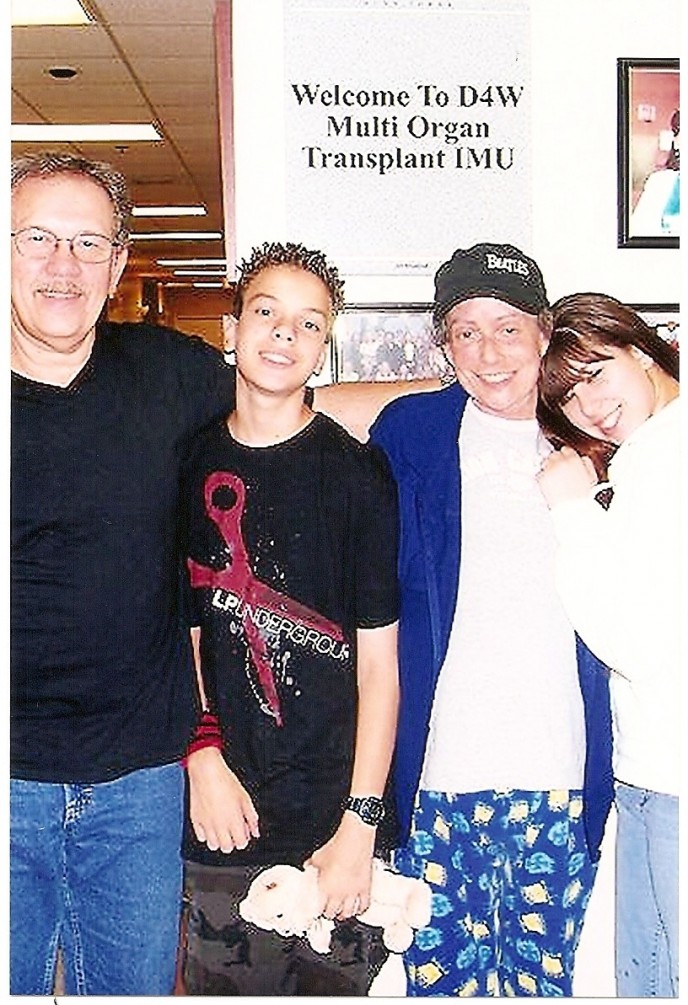Ada's Story


THE BEGINNING:
In the early 1980s Ada became pregnant. One day she experienced sudden excruciating pain, and luckily, she had the wherewithal to get herself to an emergency room. Ada had a tubal pregnancy which had burst, and she was bleeding to death internally, requiring immediate surgery. The surgeon said Ada had lost so much blood that she was literally one hour away from dying. The surgery saved her life, but of the many blood transfusions required to replace her massive blood loss, some were tainted with the Hepatitis C virus. It was unheard of until 1989 and not screened for before 1992. Many years later, the disease started showing its affects in Ada’s body in devastating ways.
FYI: “Prior to the screening of the blood supply for hepatitis C, approximately 300,000 Americans contracted hepatitis C through blood transfusions or blood products.” http://www.hcvadvocate.org/hepatitis/factsheets_pdf/Brief_History_HCV_10.pdf
PART TWO PHOENIX, AZ:
Ada's home is in Phoenix with her husband and two children, now teenagers. During a routine physical, Ada tested positive for the Hepatitis C virus, further confirmed by a liver biopsy. This was the first clue Ada had that she was even sick. She started a 12-month Interferon treatment, giving herself a shot once a week. The shot was so painful, Ada would sit in the closet and cry as she did it. At the end of this first treatment, she was hepatitis-free, but within a month, it came raging back. Ada's doctor said the treatment had not worked, and that she had an extremely resistant type of hepatitis C virus. The doctors set her up for another round of Interferon a few months later and after treatment, again told her she was hepatitis-free. The virus came back again right away, supposedly hiding out in the dead part of her liver. By now, the side effects of the extremely painful Interferon treatments were devastating Ada's body, and she was told she could not try it again. The interferon had lowered her body's resistance to such a low level, she developed a long list of major complications. Her body became covered from head to toe with painful psoriasis, developing arthritic psoriasis which caused extreme pain in her joints, for example. At one point, she became so ill, she spent 99 days in Banner Good Samaritan Hospital. Her platelet count was so low (around 3,000) the dermatologists at Good Samaritan were afraid to take a skin biopsy in case they caused her to bleed and could not stop the bleeding. Now we are just happy when Ada's platelet count falls between 40,000 to 80,000. When it came time to leave Good Samaritan, Ada was not sick enough to be in the hospital, yet too sick to go home, so she spent almost six months in a long-term-care facility. During this time her brother Dickie spent time in Phoenix helping take care of Ada, as did her mother. Her mother once stayed 17 months straight to help her get through one of her year-long Interferon treatments and the horrible side effects it caused Ada beyond treatment. Ada was suffering immensely by 2005.
FYI: In an adult, a normal count is about 150,000 to 450,000 platelets per microliter of blood. http://www.labtestsonline.org/understanding/analytes/platelet/test.html
CHRONIC COMPLICATIONS INCLUDE:
Psoriasis, Psoaritaic arthritis, Diabetes, Diabetic neuropathy, Gastroparesis, Nausea, Appetite loss, Anemia, High blood pressure, Enlarged spleen, Osteoporosis, Herniated discs in lower spine, Vertebral fracture, Sciatica, Falling with injury, Urinary tract infections, Hemorrhagic cystitis, low white and red blood cell counts, low hemoglobin, low platelet levels (Ada has frequent blood transfusions, and often has hemoglobin, albumin and platelet transfusions).
PART THREE HOUSTON, TX LIVER TRANSPLANT:
Ada came to Houston for a two-week visit in March 2008, and has not been able to go home yet. On her third day here she was admitted to the Methodist Hospital with hepatic encephalopathy, with the doctors having to induce a coma, which she came out of after about two weeks. Her doctor's called it a near- death experience. Since the first hospital experience, Ada has been to the emergency room at Methodist Hospital at least 50 times due to her varying complications, with many of those visits turning into a hospital admittance. She was put on the list for a new liver almost immediately at Methodist Transplant Center, and during this time suffered through esophageal varacies and ascities. The ascities required frequent paracentises treatments, often removing up to six liters of fluid from her abdomen at a time. Finally, a trip to the emergency room on New Year's Eve 2009, turned into a four-month stay, with her liver transplant occurring on January 13, 2010. She was re-opened the very next day to check the blood flow from her heart to her liver. She was re-opened two weeks later on February 4th to remove six liters of bloody fluid due to clotting issues. She was re-opened one last time on February 13th, as her bowels had become so twisted they were tied into a knot. Her liver surgeon said he saved her life twice. She would not have made it one more week without the liver transplant happening when it did, and he untwisted her bowels, which were choking the life out of her. We could see it in her eyes. Ada's kidneys never recovered from being opened four times within one month, and now she has End Stage Renal Disease, or complete kidney failure.
PART FOUR HOUSTON, TX KIDNEY LIST:
Ada goes to dialysis three times a week to clean her blood. I wanted so much to be able to donate a kidney to my sister, but after extensive testing at the Methodist Transplant Center they found that my kidneys only operate at 80 percent, and when my case went before the review board, I was turned down as a donor. Ada also went through extensive testing and before the review board. She was approved as a candidate who was able to accept a new kidney and was finally placed on the waiting list as of April 24, 2011. Unlike a liver transplant, which you can't live without, dialysis may keep you alive while you wait for a kidney. We were told the wait could be as long as two to three years.
FYI: "Without dialysis or a kidney transplant, death will occur from the buildup of fluids and waste products in the body." http://www.nlm.nih.gov/medlineplus/ency/article/000500.htm
PART FIVE PHOENIX, AZ KIDNEY LIST:
Someone waiting for a kidney will often get on the waiting list for a kidney in two places. This could double their chance of getting a kidney transplant, if only a few months sooner. Ada is now trying to get listed also at Banner Good Samaritan Transplant Center in Phoenix, AZ. This way, she perhaps could spend more time with her family while waiting for a kidney donation. Ada misses them so much.
Her Houston doctors, and both the Houston and Phoenix transplant centers support the action, and feel that Ada would only benefit by seeing her family, even if only a few weeks at a time. A few weeks is better than not at all. A support system of Phoenix doctors will be built, starting from the Banner Good Samaritan Transplant Center, for the time Ada gets to spend at home with her husband and children. THE POINT IS FOR ADA TO BE ABLE TO SPEND TIME IN PHOENIX WITH HER FAMILY, WITH A SUPPORT TEAM OF DOCTORS; if a kidney becomes available here first, that is a bonus.
FYI "As of 1:30 p.m. on Dec. 19, 2011, there were 90,360 people in the United States in need of a kidneytransplant." http://www.kidneytransplantblog.com/
PART SIX HOUSTON, TX KIDNEY LIST:
Forget part five. Unfortunate choice not to do it. I believe when she makes it home to Phoenix, she will need these facilities and top-notch doctors. A new kidney means you don't have to go to dialysis anymore. A miracle in itself. But the transplant does not solve all the other issues she will still need to see specialists for in Phoenix.
PART SEVEN HOUSTON, TX KIDNEY LIST:
PART EIGHT HOUSTON, TX KIDNEY LIST: 10/4/2013
A new living donor has just been tested to see if their liver is compatible to donate to Ada. Results will be back in a few weeks. The threshold for consideration, is 86% kidney function. When I (her sister) took the tests, after her kidneys failed in the spring of 2010 (her liver transplant was Jan 2010), I found out my kidneys only operate at 80%, and I was turned down as a living donor. It was a great shock to all of us, especially since Ada and I were extremely compatible for donation, and we just knew they would not say no. Maybe a new chapter will be written soon.
To change the subject, and for the last few days, Ada has been in the hospital again, not feeling very well.
